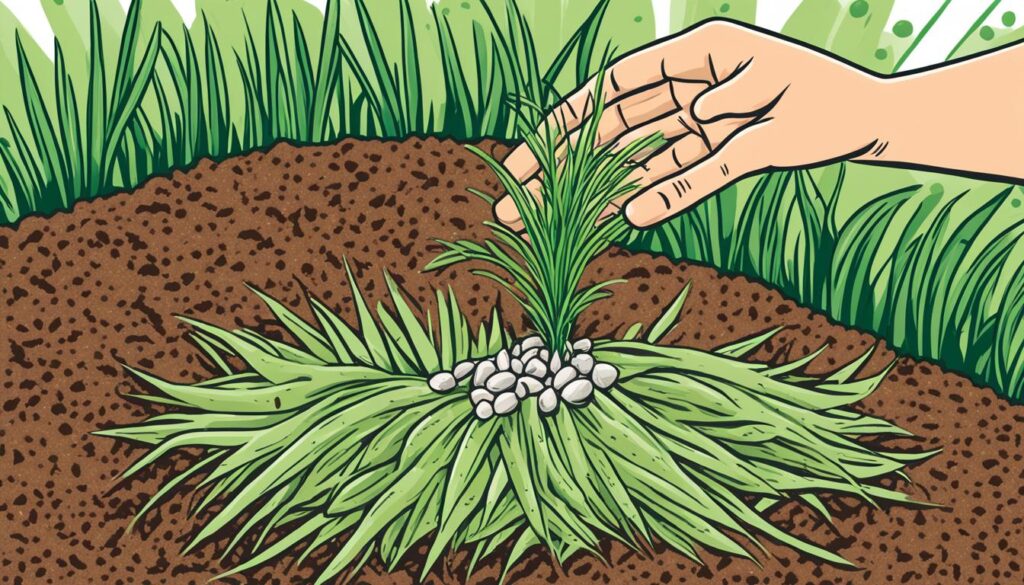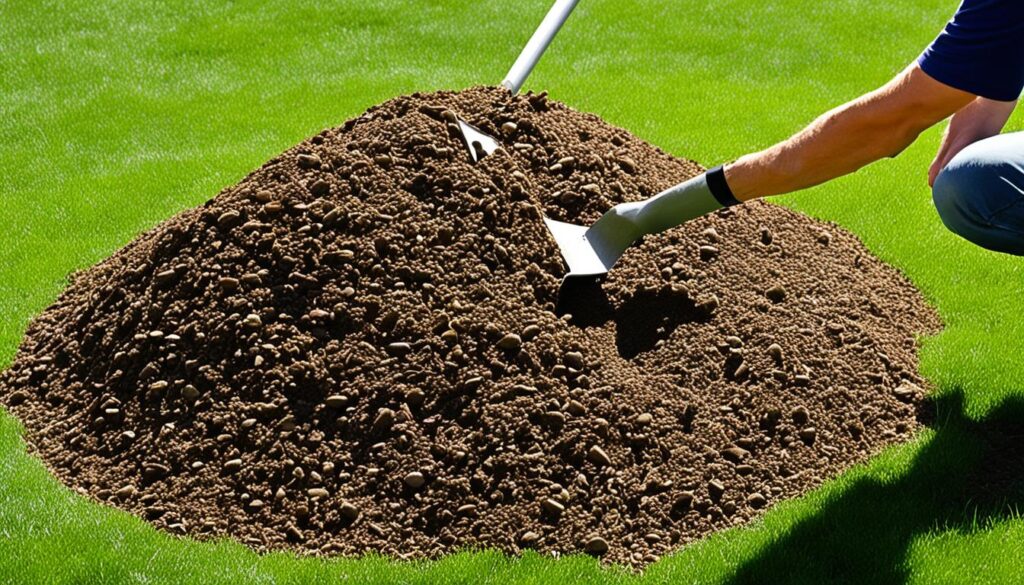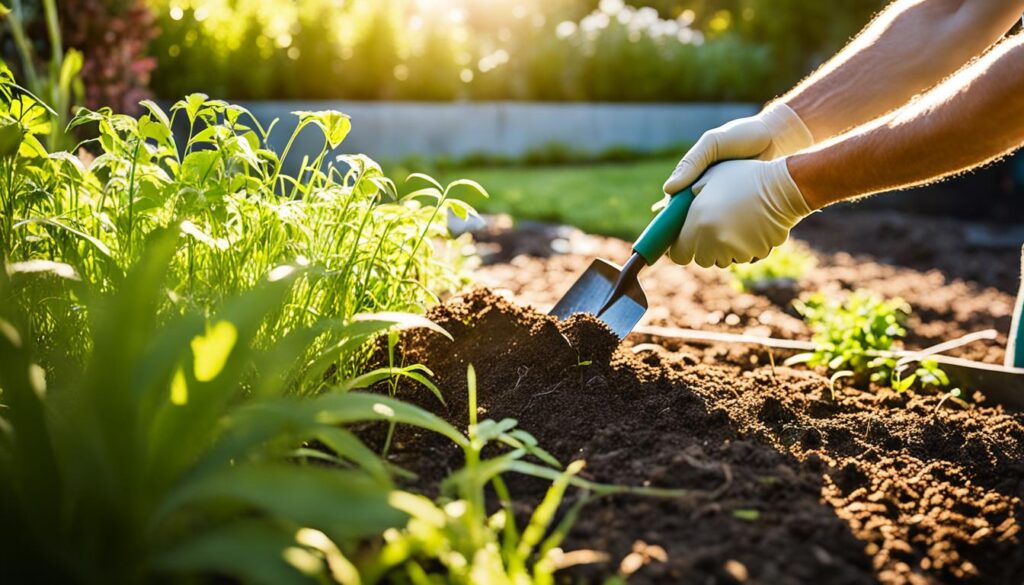How to Plant Grass Seed: A Simple Guide for Success
Are you tired of seeing brown spots on your lawn? Have you tried many ways to fix it, but nothing worked? It’s time to learn how to plant grass seed the right way.
Many think planting grass seed is easy, but it’s not. It needs careful planning and doing things right. With the right steps and some knowledge, you can make your lawn look great.
This guide will show you how to plant grass seed step by step. You’ll learn important tips and how to keep your lawn looking good. You’ll know how to pick the best grass seed and how to take care of it after planting.
Key Takeaways:
- Planting grass seed requires careful planning and execution.
- Choosing the right grass seed is crucial for successful growth.
- Preparing the soil properly sets the foundation for a healthy lawn.
- Removing weeds and clearing the area ensures optimal growth.
- There are different techniques for seeding, such as broadcasting and using a seeder.
Are you ready to learn how to plant grass seed the right way? Let’s start!
Choosing the Right Grass Seed for Your Lawn
Before you start planting grass seed, pick the right type for your lawn. The right grass seed is key to a beautiful and healthy lawn. Think about the best ways to seed your grass and the best times to plant it for growth.
Variety is Key
There are many types of grass seed, each good for different places. Find out what grass grows best in your area by looking at the weather, sunlight, and soil. Common grass seed types include:
| Grass Type | Best Suited Climate | Notable Characteristics |
|---|---|---|
| Kentucky Bluegrass | Cool-season regions | Durable, fine texture |
| Bermuda Grass | Warm-season regions | Drought-tolerant, vigorous growth |
| Fescue Grass | Adaptable to various climates | Low maintenance, shade-tolerant |
| Zoysia Grass | Warm-season regions | Drought-resistant, dense growth |
Consider Your Lawn’s Needs
Think about what your lawn needs to pick the best grass seed. Consider how much foot traffic it gets, how much sun it has, and how much you want to maintain it. For example, if your lawn gets a lot of use, choose a seed that can handle it well.
Blend or Single Variety
You can choose between a blend or a single type of grass seed. Blends mix different grass types together, offering benefits of several grasses in one. Single varieties give your lawn a uniform look. Think about what you want for your lawn to decide between a blend or a single type.
Consult with Local Experts
If you’re not sure what grass seed to pick, talk to local gardening experts or pros. They can give you advice based on your area and lawn. Local advice can help you choose the best grass seed for your lawn.

Choosing the right grass seed and following the best seeding practices can help your lawn grow lush and healthy. Think about what your lawn needs, get advice from local experts if you can, and make sure you plant the seed in the best way.
Preparing the Soil for Planting
Getting your grass seed to grow well starts with the soil. Use the right steps to make a great place for seeds to grow and thrive.
Soil Testing: First, check the soil’s pH and nutrients. You can buy a kit or send a sample to an ag office for tests. Fix the pH and nutrients to help your grass seed grow well.
Clearing the Area: Remove all plants, weeds, and debris first. Use a rake or sod cutter to clear the area. Make sure the soil is even and clear of any blocks.
Tip: Remove deep roots too, as they can stop your new grass from growing.
Loosening the Soil: After clearing, till or fork the soil a bit. This makes it better for air, water, and roots.
Leveling and Smoothing: Level the soil with a rake, removing clumps and rocks. This makes a smooth place for your seeds to grow evenly.
Fertilizing: Add a slow-release fertilizer to give your grass seed nutrients. Use the right amount based on your soil test.
Watering: Water the soil well before planting seeds. This makes sure the soil is moist and ready for seeds.

Follow these steps carefully to make a great base for your lawn. Good soil preparation is key for seed germination and healthy grass.
Clearing the Area and Removing Weeds
Before you plant grass seed, make sure the area is clean. Remove any debris and weeds. This helps your new lawn grow well.
First, look over the area and pick up any big rocks, branches, or other stuff that could stop the grass from growing. These things can make the ground uneven and stop the seeds from sprouting.
Then, deal with the weeds. They take what your grass needs to grow. You can remove weeds in different ways, based on how many there are and what you like:
- Hand pulling: Pull weeds out by hand. It works best for a few weeds or small spots. Make sure you get the whole root to stop them from coming back.
- Use of herbicides: Herbicides kill certain weeds without hurting your grass. Always read and follow the directions to use them safely and effectively. Remember, you might need to spray them more than once to get rid of all the weeds.
- Manual cultivation: For lots of weeds, use a garden cultivator or tiller. This breaks up the weed roots and makes the soil easier to clear.
After getting rid of the weeds, throw them away the right way. Don’t put them in your compost because some weeds can still spread seeds. Put them in bags and follow your area’s rules for throwing away trash.
Clearing the area and removing weeds makes a good place for your grass seed to grow. With everything ready, you’re getting closer to a lush, healthy lawn.
Benefits of Clearing the Area and Removing Weeds
| Benefits | Description |
|---|---|
| Promotes even germination | Getting rid of debris and weeds makes the ground even. This lets grass seeds grow evenly. |
| Minimizes competition | Clearing the area stops weeds from competing with your grass seed. This lets your seed grow better. |
| Enhances aesthetics | A clean lawn looks better and makes your yard more inviting. |
| Reduces weed resurgence | Removing weeds stops them from spreading and taking over your new lawn. |

Seeding Techniques: Broadcasting vs. Using a Seeder
Choosing the right way to seed your grass is key. You can use broadcasting or a seeder. Each method has its own benefits and things to think about. Knowing the differences helps get the best results with your grass seed.
Broadcasting Grass Seed
Broadcasting means spreading the seed by hand over the area. It’s good for small areas or tricky spots.
“Broadcasting lets you control where the seed goes and covers hard spots well,” says John Thompson, a pro at Green Oasis Lawns.
Here’s how to spread the seed well:
- Clean the soil of rocks, weeds, and debris.
- Spread the seed evenly by hand, from one side to the other.
- Rake the seed into the soil for better contact.
Broadcasting is easy and cheap but takes more work and care for even spreading.
Using a Seeder
For big areas, a seeder is faster and spreads seeds evenly. There are different seeders like drop and broadcast spreaders for various needs.
“A seeder makes seeding big lawns quicker,” says Sarah Davis, a pro at Perfect Green Lawns.
Follow these steps with a seeder:
- Pick the right seeder for your lawn size and seed amount.
- Set the seeder to spread the right amount of seed.
- Walk across the lawn in straight lines, overlapping each pass for even spread.
- Rake the soil lightly to cover the seed and help it stick.
A seeder is quicker and easier for big lawns. But think about your lawn’s size and shape before using one.
| Technique | Advantages | Considerations |
|---|---|---|
| Broadcasting | More control over where seeds go Works well on tough spots |
Takes more effort and precision Not great for big areas |
| Using a Seeder | Seeds faster and more evenly Even spread |
Needs a seeder to buy or rent Not best for small or uneven lawns |
Choose your method wisely and follow best practices like soil prep, watering, and upkeep. The right seeding methods lead to a lush, healthy lawn.
Spreading the Grass Seed
Now you’ve picked the best grass seed and got the soil ready. It’s time to spread the seed. Follow these steps for even seed distribution and a successful planting.
Step 1: Prepare the Seed
Check the seed packaging for any special instructions. Mixing the seed with organic mulch or sand (1:10) helps with spreading and prevents clumps.
Step 2: Choose the Right Spreader
There are two types of spreaders: drop and broadcast. Drop spreaders are great for small areas and precise spreading. Broadcast spreaders work well for bigger areas.
Step 3: Calibrate the Spreader
Calibrate your spreader as the maker says. This makes sure the seed spreads evenly and you use the right amount.
Step 4: Start Spreading
Start by walking slowly in straight lines, a bit overlapping each row. This fills in gaps and covers the area well.
Step 5: Overseed for Best Results
For a fuller lawn, add more seed over the first layer. This fills thin spots and makes the lawn thicker.
Water the new seed right after spreading to help it grow. Next, we’ll talk about how to water your new grass.
Watering and Irrigation
Watering and irrigation are key to a successful grass seed planting. To get the best growth and establishment of your lawn, follow these tips. They will help you water your lawn right.
1. Watering Frequency
Keep the soil moist after you plant the grass seed. Water lightly often, instead of heavy watering once. Keep the top inch of soil damp for 2-3 weeks while it germinates.
Once the grass seedlings grow, water less often but give more water each time. This helps the grass grow strong roots.
2. Watering Depth
Water deeply to help the grass roots grow strong. Water enough to go deep into the soil, at least 6 inches. This makes the roots grow down, making the grass tough against drought and stress.
3. Time of Day
Water your lawn in the early morning. This lets the grass dry before night, cutting down on disease and fungus. In hot months, you might water in the late afternoon too, to help the grass during the hottest part of the day.
4. Moisture Monitoring
Check the soil’s moisture often to make sure it’s getting enough water. Dig a small hole 4-6 inches deep and feel the soil. If it’s dry, it’s time to water. It’s better to water deeply not often, than a little at a time.
By using these watering tips, you can grow a lush, healthy lawn. Good watering, along with the right soil and seed, will make your grass seed planting a success.
| Stage | Watering Frequency | Watering Time |
|---|---|---|
| Germination Period | Light watering multiple times daily | Morning, afternoon, and early evening |
| Seedling Growth | Gradually reduce frequency, increase water per session | Morning or late afternoon |
| Established Lawn | Water deeply once per week (may increase during hot, dry periods) | Morning or late afternoon |
Mulching for Moisture Retention
Mulching is key to making your grass seed planting work. It puts a layer of organic or inorganic stuff on the soil. This helps keep moisture in, keeps soil temperature right, stops weeds, and prevents soil from washing away.
Here are some tips for mulching to keep moisture in:
- Pick the right mulch: Use things like straw, wood chips, or compost. They break down and add nutrients to the soil. They also make the soil better at draining.
- Spread it out evenly: Put the mulch down about 2-3 inches thick. Don’t put it too close to the grass seedlings to avoid rot or disease.
- Think about color and texture: Dark mulch gets hotter, good for cool places. But in hot areas, light-colored mulch reflects sunlight and keeps the soil cooler.
- Check the soil’s moisture: Make sure the soil under the mulch stays moist but not too wet. Water it when it needs it.
- Watch for weeds: Mulch stops weeds by blocking sunlight and preventing seeds from growing. But, pull out any weeds that get through the mulch.
Mulching Material Pros and Cons
| Mulching Material | Pros | Cons |
|---|---|---|
| Straw | – Keeps warm – Breaks down naturally – Saves money |
– May have weed seeds – Attracts pests |
| Wood Chips | – Lasts a long time – Makes soil better – Stops weeds |
– Needs extra nitrogen – Can be pricey |
| Compost | – Adds nutrients – Keeps moisture in – Helps good bugs |
– May have weed seeds – Needs regular use |
Using these mulching tips will help your grass seeds grow well. Remember, mulch keeps moisture in, so you won’t need to water as much. With good mulching, your seeds will grow strong and your lawn will be green and healthy.
Protecting the Newly Seeded Area
After you plant grass seed, you need to protect it for it to grow well. Following expert advice on planting grass seed helps a lot. Here are some steps to keep your lawn safe:
1. Establishing a Protective Barrier
Use straw, hay, or erosion control blankets to protect the seeds. These things keep the soil moist and stop the seeds from being eaten or washed away.
2. Marking the Seeded Area
Mark the area with temporary fencing, stakes, or signs. This stops people from walking on it by mistake. It also keeps lawn equipment away from the seeds.
3. Limiting Foot Traffic
Don’t walk on the new grass as much as you can. This stops the soil from getting hard. Ask family and guests to use other paths until the grass grows well.
4. Minimizing Watering Disturbances
Water the seeds gently with a mist or a small watering can. This keeps the soil moist without washing away the seeds or hurting the new grass.
5. Monitoring for Weed Growth
Check the area often for weeds. Pull them out quickly to stop them from taking over. Be careful not to hurt the new grass when you weed.
By following these tips and expert advice, you can protect your new grass. This will help it grow strong and healthy. Taking care of your lawn will give you a beautiful, green area.
| Benefits of Protecting the Newly Seeded Area | Challenges of Neglecting Protection |
|---|---|
| 1. Enhanced moisture retention for seed germination | 1. Increased risk of seed washout |
| 2. Prevention of seed predation by birds and wildlife | 2. Damage caused by foot traffic |
| 3. Reduced competition from weeds | 3. Weed infestation and stunted grass growth |
| 4. Protection against soil erosion | 4. Uneven distribution of grass seeds |
Post-Planting Care and Maintenance
After you plant grass seed, you’re not done yet. Taking good care of your lawn after planting is key for its health. I’ll share expert tips on how to make your new lawn thrive.
Watering
Watering your lawn right after seeding is very important. The seeds need moisture to grow and get strong roots. Water the area often but a little at a time to keep it moist.
This stops the soil from drying out or getting too wet, which can stop the seeds from growing. Watch the weather and change your watering as needed.
Mowing
Change how you mow your lawn after you seed it. Wait until the new grass is about 3 to 4 inches tall before you cut it. Set your mower to cut higher to avoid hurting the young grass.
Cutting it too short can stress the plants and slow their growth. Mowing at the right height helps the roots grow strong and your lawn stay lush.
Fertilizing
Feeding your new lawn with fertilizer can help it grow strong. But wait until the grass has strong roots before you start. This usually takes about 4 to 6 weeks after seeding.
Use a slow-release fertilizer made for new lawns and follow the package directions. Too much or the wrong kind of fertilizer can hurt the young grass.
Weed Control
Stopping weeds is key for your new grass to succeed. Weeds take away sunlight, water, and food from the seedlings. Check the area often and pull weeds by hand.
Avoid herbicides until the grass is strong enough to handle them. This prevents damage to your new lawn.
Patience and Observation
Getting a new lawn from seed takes time and watching over it. Keep an eye on your lawn and fix any problems quickly. Notice any bare spots and reseed them.
With care and patience, your new grass will grow into a beautiful lawn.
Summary
Looking after your lawn after planting is key to its success. By watering, mowing, fertilizing, controlling weeds, and watching over it, you can make sure your new lawn stays healthy and looks great.
Troubleshooting Common Grass Seed Planting Issues
Even with careful planning, you might face problems when planting grass seed. I’ll cover common issues and give tips to fix them.
1. Patchy Germination
Patchy germination can happen for many reasons, like not spreading the seeds well or not watering enough. Here’s how to fix it:
- Clear the soil of debris and make it loose with a rake.
- Spread the seeds out evenly with a seeder or by hand.
- Keep the soil moist but not too wet by watering regularly.
- Don’t overwater, as it can cause seed rot or disease.
2. Weed Invasion
Weeds can stop new grass from growing. Here’s how to keep them away:
- Remove weeds before planting with a weed killer if needed.
- Use a pre-emergent herbicide to stop weed seeds from growing.
- Cover the seeded area with mulch to stop weeds from coming up.
- Check the area often and pull out any weeds by hand.
3. Pests and Diseases
Pests and diseases can harm your grass seedlings. Here’s what to do:
- Find out what pest or disease is bothering your lawn.
- Ask a gardening expert or your local extension service for advice.
- Use the right insecticides or fungicides as told.
- Keep your lawn healthy with regular mowing and good drainage.
Every problem is different, so you need to look at it closely before fixing it. If you’re not sure what to do, get help from a local gardening pro.
Timing the Grass Seed Planting
Getting the timing right is key for growing a healthy lawn. The best time to plant grass seed depends on your area, the weather, and the type of grass you want. Experts share tips on when to plant for the best results.
Consider Your Region and Climate
Think about your area’s climate before planting grass seed. Each type of grass grows best in certain temperatures. Knowing your climate helps you pick the perfect time to plant.
In northern areas with cold winters, cool-season grasses like Kentucky bluegrass and fescue work well. They grow best in 60°F to 75°F (15°C to 24°C). Plant them in early spring or fall to beat the extreme weather.
In southern regions with hot summers, warm-season grasses are best. Bermuda grass, zoysia grass, and centipede grass are good choices. Plant these in late spring or early summer when it’s warm enough.
Monitor Soil Temperature
Soil temperature is key for grass seed growth. Check the soil temperature before planting. The best soil temperature for germination varies by grass type.
Warm-season grasses like Bermuda grass need soil over 70°F (21°C) to start. Cool-season grasses, such as Kentucky bluegrass, do well in 50°F to 65°F (10°C to 18°C) soil.
Use a soil thermometer or local weather info to check soil temperature. Soil temperature is slower to rise than air temperature. So, check often to find the best planting time.
Maximize Precipitation and Minimize Competition
Planting at the right time means choosing when it’s wet or when you can water well. Moist soil is vital for seed germination and early growth.
Also, plant when weeds are less likely to compete with your new grass. For warm-season grasses, plant in late spring to use natural rain and avoid weeds. For cool-season grasses, fall is best when weeds are fewer.
Maintaining a Healthy Lawn
Once your grass seed grows into a beautiful lawn, keeping it healthy is key. Here are some tips to keep your lawn looking great:
- Regular mowing: Cut your lawn often. Set your mower to the right height for your grass. Cut off the top third of the grass each time you mow.
- Proper watering: Water your lawn deeply but not too often. Aim for 1 inch of water a week, from rain or a hose. Check local rules about watering.
- Fertilizing: Use a good fertilizer for your grass type. Follow the directions on the package to feed your lawn well and keep it green.
- Weed control: Check your lawn for weeds often. Pull them out by hand or use a special spray to stop them. This keeps your lawn looking good.
- Aerating: Aerate your lawn once a year to help it breathe better. Use a special tool to make holes in the soil. This lets air, water, and nutrients get to the roots.
- Overseeding: If your lawn has bare spots, overseed them. This makes your lawn thicker and prettier. Just follow the right steps for seeding.
- Proper maintenance: Keep your lawn clean by removing leaves and twigs. Be careful with heavy things on your lawn to avoid damage.
Expert Tip: Test Your Soil
If your lawn is struggling, getting your soil tested might help. Universities, extension offices, or lawn care pros can check your soil. They can tell you if it’s too acidic or lacking nutrients. Then, you can fix it to help your lawn grow better.
| Task | Frequency |
|---|---|
| Mowing | Once a week during active growth |
| Watering | Deeply and infrequently; 1 inch of water per week |
| Fertilizing | 2-4 times per year, following package instructions |
| Weed control | As needed; regular inspections and removal |
| Aerating | Once a year, preferably in the spring or fall |
| Overseeding | As needed; targeted areas with thin or bare grass |
| Debris removal | Regularly; especially after storms or windy days |
Conclusion
Planting grass seed is easy and fun with the right steps. This guide will help you make your lawn look great. Follow these tips to make your lawn lush and green.
Start your grass seed planting today. You’ll love the beautiful lawn you get. It will make your neighbors jealous.







